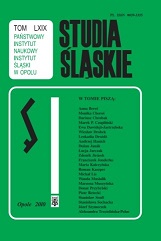Nowe elementy w krajobrazie kulturowym Nysy po 1989 roku. Pomniki i tablice pamiątkowe
The new elements in the cultural landscape of Nysa after 1989. The monuments and commemorative tablets
Author(s): Ewa Dawidejt-JastrzębskaSubject(s): Cultural Essay, Political Essay, Societal Essay
Published by: Instytut Śląski
Keywords: permanent commemorations; Nysa since 1989; cultural landscape; monuments and tablets
Summary/Abstract: The paper deals with new permanent commemorations (in the form of monuments and tablets) which have appeared within the public space of Nysa since 1989. The material discussed by the author relates to over 40 commemorations. The analysis concerns primarily the objects themselves and the message they carry. Following the political breakthrough, in the cultural landscape of Nysa there appeared references to this part of the national tradition which was passed over in silence or even forbidden in the times of the polish people’s republic since it was connected with crimes and misdeeds of the Soviet union and the historical-cultural heritage of the displaced from the Former eastern lands of Poland. These commemorations are an expression of homage to the glorious military deeds or martyrdom of the nation. The largest number of the permanent commemorations within the cultural landscape of Nysa in the years of the transformation have been related to the time of the city’s German national status. They are dedicated to the activity of monastic centers and their founders (St Arnold Janssen, blessed Samaritan Maria Luiza Merkert), also to the discoverer of stains on the Sun (Christoph Scheiner), to poets (Joseph von Eichendorff, max Herrmann-Neisse), to a Nobel prizewinner (Konrad Emil Bloch), to a famous zoologist (Bernhard Grzimek). The tables making reference to the post-war history of Nysa commemorate the 50thanniversary of a school, poets connected with Nysa (Jerzy Kozarzewski, Wanda Pawlik) and also rising the St Jacob and St Agnes church to the rank of a basilica.
Journal: Studia Śląskie
- Issue Year: 2010
- Issue No: 69
- Page Range: 85-106
- Page Count: 22
- Language: Polish

